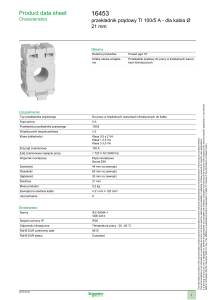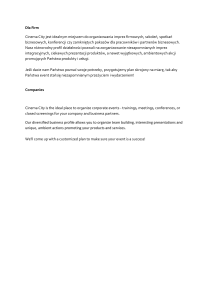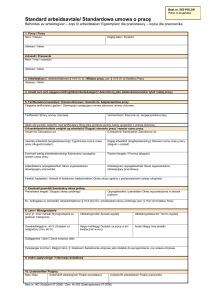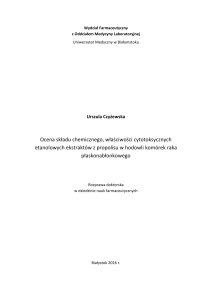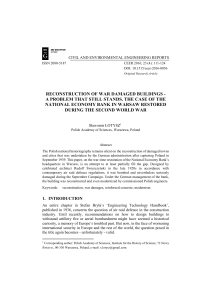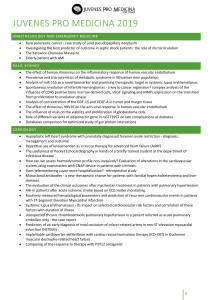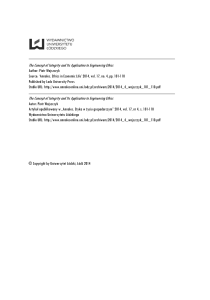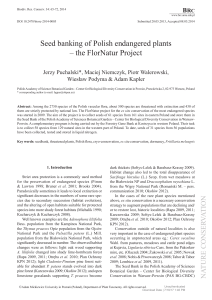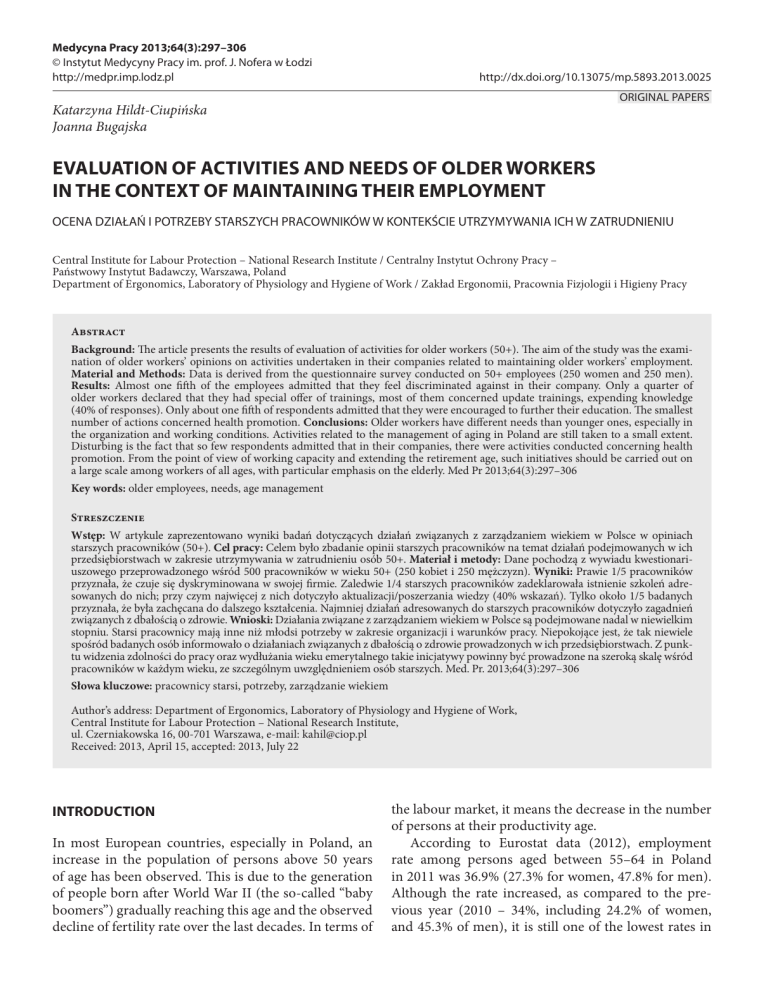
Medycyna Pracy 2013;64(3):297–306
© Instytut Medycyny Pracy im. prof. J. Nofera w Łodzi
http://medpr.imp.lodz.pl
http://dx.doi.org/10.13075/mp.5893.2013.0025
ORIGINAL PAPERS
Katarzyna Hildt-Ciupińska
Joanna Bugajska
EVALUATION OF ACTIVITIES AND NEEDS OF OLDER WORKERS
IN THE CONTEXT OF MAINTAINING THEIR EMPLOYMENT
OCENA DZIAŁAŃ I POTRZEBY STARSZYCH PRACOWNIKÓW W KONTEKŚCIE UTRZYMYWANIA ICH W ZATRUDNIENIU
Central Institute for Labour Protection – National Research Institute / Centralny Instytut Ochrony Pracy –
Państwowy Instytut Badawczy, Warszawa, Poland
Department of Ergonomics, Laboratory of Physiology and Hygiene of Work / Zakład Ergonomii, Pracownia Fizjologii i Higieny Pracy
Abstract
Background: The article presents the results of evaluation of activities for older workers (50+). The aim of the study was the examination of older workers’ opinions on activities undertaken in their companies related to maintaining older workers’ employment.
Material and Methods: Data is derived from the questionnaire survey conducted on 50+ employees (250 women and 250 men).
Results: Almost one fifth of the employees admitted that they feel discriminated against in their company. Only a quarter of
older workers declared that they had special offer of trainings, most of them concerned update trainings, expending knowledge
(40% of responses). Only about one fifth of respondents admitted that they were encouraged to further their education. The smallest
number of actions concerned health promotion. Conclusions: Older workers have different needs than younger ones, especially in
the organization and working conditions. Activities related to the management of aging in Poland are still taken to a small extent.
Disturbing is the fact that so few respondents admitted that in their companies, there were activities conducted concerning health
promotion. From the point of view of working capacity and extending the retirement age, such initiatives should be carried out on
a large scale among workers of all ages, with particular emphasis on the elderly. Med Pr 2013;64(3):297–306
Key words: older employees, needs, age management
Streszczenie
Wstęp: W artykule zaprezentowano wyniki badań dotyczących działań związanych z zarządzaniem wiekiem w Polsce w opiniach
starszych pracowników (50+). Cel pracy: Celem było zbadanie opinii starszych pracowników na temat działań podejmowanych w ich
przedsiębiorstwach w zakresie utrzymywania w zatrudnieniu osób 50+. Materiał i metody: Dane pochodzą z wywiadu kwestionariuszowego przeprowadzonego wśród 500 pracowników w wieku 50+ (250 kobiet i 250 mężczyzn). Wyniki: Prawie 1/5 pracowników
przyznała, że czuje się dyskryminowana w swojej firmie. Zaledwie 1/4 starszych pracowników zadeklarowała istnienie szkoleń adresowanych do nich; przy czym najwięcej z nich dotyczyło aktualizacji/poszerzania wiedzy (40% wskazań). Tylko około 1/5 badanych
przyznała, że była zachęcana do dalszego kształcenia. Najmniej działań adresowanych do starszych pracowników dotyczyło zagadnień
związanych z dbałością o zdrowie. Wnioski: Działania związane z zarządzaniem wiekiem w Polsce są podejmowane nadal w niewielkim
stopniu. Starsi pracownicy mają inne niż młodsi potrzeby w zakresie organizacji i warunków pracy. Niepokojące jest, że tak niewiele
spośród badanych osób informowało o działaniach związanych z dbałością o zdrowie prowadzonych w ich przedsiębiorstwach. Z punktu widzenia zdolności do pracy oraz wydłużania wieku emerytalnego takie inicjatywy powinny być prowadzone na szeroką skalę wśród
pracowników w każdym wieku, ze szczególnym uwzględnieniem osób starszych. Med. Pr. 2013;64(3):297–306
Słowa kluczowe: pracownicy starsi, potrzeby, zarządzanie wiekiem
Author’s address: Department of Ergonomics, Laboratory of Physiology and Hygiene of Work,
Central Institute for Labour Protection – National Research Institute,
ul. Czerniakowska 16, 00-701 Warszawa, e-mail: [email protected]
Received: 2013, April 15, accepted: 2013, July 22
INTRODUCTION
In most European countries, especially in Poland, an
increase in the population of persons above 50 years
of age has been observed. This is due to the generation
of people born after World War II (the so-called “baby
boomers”) gradually reaching this age and the observed
decline of fertility rate over the last decades. In terms of
the labour market, it means the decrease in the number
of persons at their productivity age.
According to Eurostat data (2012), employment
rate among persons aged between 55–64 in Poland
in 2011 was 36.9% (27.3% for women, 47.8% for men).
Although the rate increased, as compared to the previous year (2010 – 34%, including 24.2% of women,
and 45.3% of men), it is still one of the lowest rates in
298
K. Hildt-Ciupińska, J. Bugajska
the EU. The average rate for the EU is 47.7% (40.2% for
women, 55.2% for men) (1).
Currently, various activities are being undertaken in
order to minimize the consequences of the unavoidable
process of aging. One of them is called “age management”, it is defined as an element of human resources
management or a part of widely-understood diversity
management (combating age, gender and religious discrimination). Its objective is to conduct activities which
allow for a more effective use of human resources in
companies by taking into account the needs and capabilities of employees of all ages (2). The scope of activities targeted at employees above 50 years old, which are
performed for the purpose of effective age management,
includes initiatives related to: recruitment, health care,
lifelong learning, career development, and organization
of work and working conditions.
The purpose of this study was to analyze the opinion of older employees on the activities implemented at
their companies in terms of maintaining the employment of 50+ workers.
MATERIAL AND METHODS
The research was conducted among 500 workers aged
50+ (250 women and 250 men) who were employed at
small (10–49 workers), middle (50–249 workers) and
big (over 249 workers) companies that represent section 5 of the Polish Classification of Activity (PKD 2007) (3):
Manufacturing, Construction, Wholesale and Retail Trade
and the Repair of Motor Vehicles, Administrative and
Support Service Activities, Human Health and Social Work
Activities. Given the structure of companies in Poland (4),
micro-enterprises (0–9) were not included in the research
as their number is the highest, and in this case, proportional sampling could lead to their overrepresentation. The
sampling was of amount and quota nature and was conducted by taking into account three key features: gender,
size of the business, affiliation to one of PKD 2007 sections.
The selection of companies was performed in Mazovian
Voivodship. The persons, who participated in the study,
represented both private companies (250 persons) and
public sector (250 persons). The sample N = 500 (at confidence level 0.95, estimated fraction of 0.5 and maximal
error of 0.04) was chosen from the population N = 8000.
The selection of the types of economic activity was
determined by GUS (Główny Urząd Statystyczny –
Central Statistical Office of Poland) study (5), which
clearly indicates that the three chosen sections have the
biggest number of employees over 50 years old.
Nr 3
In the study, the diagnostic poll method was applied
with anonymous survey that was developed for the purpose of the study on the basis of available reference material (6–9). It contained several parts regarding such
aspects as:
n recruitment (questions related to the benefits of hiring 50+ workers; factors taken into account while
recruiting 50+);
n lifelong learning, professional development (questions about: type of training in which 50+ workers
take part, possibilities of further education for 50+
workers, training of younger employees provided by
older employees, training of older employees provided
by younger colleagues, promoting older employees);
n organization of work and working conditions (questions about: flexible working time, extra leave, mobility between positions, more frequent inspections
of working stations of 50+ workers; modification
of working stations, occupational safety and health,
the needs of 50+ workers as to the organization of
work and working conditions);
n health (health care) of 50+ workers (questions
about: package of medical services, passes to physical activities, training/counseling related to healthy
lifestyle, training/counseling related to aging and the
methods of its delaying, training/counseling related
to occupational safety and health).
Statistical analysis of results
The statistical analysis was carried out using SPSS 16.0
software. Chi-square test was used to analyze the relation between the tested variables.
Description of the examined sample
From among the tested employees, the oldest person
was 75 years old. The average length of service varied between 16 and 53 years and, at the present place of employment, during the survey, it ranged from 1 to 40 years. The
biggest group comprised of persons with post-secondary
education or secondary professional education (33%) and
persons performing mental work (40%). In terms of positions, most of the examined persons (20%) worked as
“personal service workers and vendors”, at the second place
there were “specialists” (about 19%). As to the positions, the
study shows significant statistical differences between men
and women. Considerably more women than men were
employed as office workers (23.2% and 6.8% respectively).
However, at managerial positions men were employed
slightly more often than women (Table 1). The remaining
data describing the group tested is shown in Table 1.
299
Table 1. Characteristics of the study group
Tabela 1. Charakterystyka badanej grupy
Respondents
Badani
(N = 500)
[%]
Parameters
Parametry
p
total
ogółem
women
kobiety
men
mężczyźni
5.0
3.6
6.4
married / mężatka/żonaty
67.2
67.2
67.2
widow/widower / wdowa/wdowiec
15.4
16.0
14.8
divorced / rozwiedziona(y)
12.4
13.2
11.6
tertiary / wyższe magisterskie i równorzędne
21.8
23.2
20.4
post-secondary and vocational secondary / policealne lub średnie zawodowe
33.4
31.6
35.2
general secondary / średnie ogólnokształcące
23.2
28.0
18.4
basic vocational / zasadnicze zawodowe
17.6
13.6
21.6
lower secondary, primary and incomplete primary / gimnazjalne lub niższe
1.4
0.8
2.0
no data / brak danych
2.6
2.8
2.4
via the agency agreement / umowa za pośrednictwem agencji zatrudnienia
64.3
66.8
61.7
contract for an indefinite period / umowa o pracę na czas nieokreślony
21.7
21.2
22.2
fixed-term contract / umowa o pracę na czas określony
8.2
7.2
9.3
written order / umowa zlecenie
2.8
1.6
4.0
contract work / umowa o dzieło
1.8
1.6
2.0
no data / brak danych
4.6
1.6
0.8
managers / kierownicy
13.0
11.6
14.4
professionals / specjaliści
18.6
18.4
18.8
technicians and associate professionals / technicy i inny średni personel
11.0
11.6
10.4
office workers / pracownicy biurowi
15.0
23.2
6.8
service and sales workers / pracownicy usług osobistych i sprzedawcy
20.2
22.8
17.6
craft and related trades workers / robotnicy przemysłowi i rzemieślnicy
4.2
2.8
5.6
plant and machine operators and assemblers / operatorzy i monterzy maszyn
4.8
0.4
9.2
11.2
7.2
15.2
2.0
2.0
2.0
psychological demanding work, white-collar workers / umysłowa
40.6
51.2
30.0
physical demanding work, blue-collar workers / fizyczna
25.8
20.4
31.2
psychological and physical demanding work, gray-collar workers / mieszana
29.0
22.8
35.2
4.9
5.6
3.6
Marital status / Stan cywilny
single / panna/kawaler
ns
Education / Wykształcenie
< 0.040
Type of employment contract / Rodzaj umowy o pracę
ns
Type of profession / Zajmowane stanowisko
elementary occupation / wykonujący proste prace
no data / brak danych
< 0.005
Type of work / Rodzaj wykonywanej pracy
no data / brak danych
ns – not significant / nieistotne statystycznie.
< 0.005
300
K. Hildt-Ciupińska, J. Bugajska
RESULTS
About 25% persons (incl. 25% of women and 21% of
men) changed their job after turning 50 years old. The
respondents mentioned various reasons which were
grouped into a few categories according to the frequency they were mentioned:
n redundancy (“older workers were laid off ”), dissolution of the company,
n health problems,
n getting other (better-paid) job,
n retiring and getting another extra job,
n no qualifications.
Over 93% of the respondents (similar figures for men
and women) revealed that they maintain good relations
with younger colleagues. More than 87% of workers
felt they were necessary for their companies. Moreover,
a significant proportion of persons (almost 80%) felt
they were recognized at their companies for their knowledge and experience. More than half of the respondents
Nr 3
did the job that corresponded to their learned profession and skills. Only 1/5 of the tested persons were discriminated for their age (Table 2).
Recruitment
Most of the respondents admitted that during the recruitment process, companies focus mainly on knowledge, skills, experience and education. At the same time,
more than 40% revealed that the age of an employee is
also significant (Table 3).
Lifelong training / professional development
Overall, almost 40% of workers admitted that 50+
workers take part in all courses, trainings, conferences
organized by their companies, but only around 25% of
workers admitted that at their companies, there have
been trainings, courses, conferences addressed specially
to older workers. More than 37% of workers claimed that
they are provided with trainings/courses that improve
skills. A large percentage of workers (43%) indicated they
Table 2. General feelings of 50+ workers related to their work
Tabela 2. Ogólne odczucia pracowników 50+ dotyczące ich pracy
Respondents
Badani
(N = 500)
[%]
Feelings
Odczucia
p
total
ogółem
women
kobiety
men
mężczyźni
I feel discriminated / Czuję się dyskryminowana(y) w firmie
18.0
18.0
18.0
ns
I have good contact with young workers / Utrzymuję dobre relacje z młodszymi kolegami
93.6
96.4
90.8
< 0.03
I feel that I’m needed in the company / Czuję się potrzebna(y) w firmie
86.8
90.0
83.6
< 0.04
I have a sense of recognition in the company because of my knowledge/experience / Czuję, że mam
uznanie w firmie ze względu na moją wiedzę/doświadczenie
79.6
80.0
79.2
ns
My work tasks are / Powierzane mi prace są:
ns
consistent with my learned profession, corresponding to my skills / zgodne z wyuczonym zawodem,
odpowiadające moim umiejętnościom
54.8
53.6
56.0
consistent with my learned profession, but overstated in relation to my skills / zgodne z wyuczonym
zawodem, ale zawyżone w stosunku do moich umiejętności
13.4
10.4
16.4
5.4
6.0
4.8
16.8
20.4
13.2
inconsistent with the learned profession and overstated in relation to my skills / niezgodne
z wyuczonym zawodem i zawyżone w stosunku do moich umiejętności
5.2
5.6
4.8
inconsistent with the learned profession and understated in relation to my skills / niezgodne
z wyuczonym zawodem i zaniżone w stosunku do moich umiejętności
3.6
2.8
4.4
consistent with my learned profession, but understated in relation to my skills / zgodne z wyuczonym
zawodem, ale zaniżone w stosunku do moich umiejętności
inconsistent with the learned profession, but my skills are corresponding / niezgodne z wyuczonym
zawodem, ale odpowiadające moim umiejętnościom
Abbreviations as in Table 1 / Objaśnienia jak w tabeli 1.
301
Table 3. Types of activities in the company undertaken with reference to 50+ workers
Tabela 3. Rodzaje działań podejmowanych w firmie ukierunkowanej na pracowników 50+
Respondents
Badani
(N = 500)
[%]
Activities
Działania
p
total
ogółem
women
kobiety
men
mężczyźni
education / wykształcenie
61.6
66.8
56.4
< 0.05
experience / doświadczenie
79.8
80.0
78.8
ns
knowledge and skills / wiedza i umiejętności
80.4
82.4
78.4
ns
age / wiek
43.2
45.2
41.2
ns
knowledge of foreign languages / znajomość języków obcych
40.4
43.6
45.6
ns
computer skills / obsługa komputera
48.6
53.6
43.6
< 0.02
39.8
43.2
36.4
ns
24.8
26.4
23.2
ns
update trainings, expending knowledge / szkolenia aktualizujące/poszerzające wiedzę
40.2
44.0
36.4
< 0.01
trainings, courses / szkolenia, kursy podnoszące kwalifikacje
37.4
39.6
35.2
< 0.01
computer courses / kursy komputerowe
27.8
30.0
25.6
< 0.00
foreign language courses / kursy języków obcych
15.6
16.4
14.8
< 0.05
Recruitment – factors to be taken into account when recruiting staff / Rekrutacja – czynniki brane
pod uwagę podczas rekrutacji pracowników
Professional development / Rozwój zawodowy
participation of 50+ workers in all conferences, trainings, courses offered by companies / uczestnictwo
pracowników 50+ we wszystkich konferencjach, szkoleniach, kursach oferowanych przez firmę
Trainings for 50+ workers / Adresowanie szkoleń do pracowników 50+
Participation in the above courses / Uczestnictwo w powyższych szkoleniach
yes / tak
< 0.01
38.8
44.8
32.8
proposed, but for personal reasons I did not take part / proponowano, ale z przyczyn osobistych
nie brałem udziału
8.2
9.2
7.2
proposed, but I wasn’t interested / proponowano, ale nie byłam(em) zainteresowany
6.2
6.0
6.4
43.0
38.4
47.6
Encouragement of employees to further their education (e.g. through funding, additional leave) /
Zachęcanie pracowników do dalszego kształcenia (np. poprzez dofinansowanie, dodatkowe urlopy)
23.2
22.0
24.4
ns
Involving 50+ employees in the training of younger workers / Angażowanie pracowników 50+
w szkolenie młodszych pracowników
46.4
44.8
48.0
ns
The participation of 50+ workers in training by younger workers (e.g. on computer operation
or new information technologies) / Szkolenie pracowników 50+ przez młodszych pracowników
(np. w zakresie obsługi komputera lub nowych technologii informacyjnych)
37.8
44.0
31.6
< 0.010
Promotion of 50+ workers / Awansowanie pracowników 50+
35.6
31.6
39.6
ns
materials, information / materiały, informacje
76.0
76.8
75.2
ns
trainings, courses / szkolenia, kursy
63.2
61.6
64.8
ns
not proposed / nie proponowano
Equal (compared with younger) access to the resources of companies / Równy (w porównaniu
z młodszymi) dostęp pracowników 50+ do zasobów firmy
302
K. Hildt-Ciupińska, J. Bugajska
Nr 3
Table 3. Types of activities in the company undertaken with reference to 50+ workers – cont.
Tabela 3. Rodzaje działań podejmowanych w firmie ukierunkowanej na pracowników 50+ – cd.
Respondents
Badani
(N = 500)
[%]
Activities
Działania
p
total
ogółem
women
kobiety
men
mężczyźni
50+ workers are asked about their satisfaction with work-related conditions and organization
of work / pracownikom 50+ zadaje się pytania o ich satysfakcję z pracy związaną z warunkami
i organizacją pracy
35.6
33.6
37.6
ns
work conditions are good and meet my needs / warunki pracy są dobre i odpowiadają moim
potrzebom
74.0
74.0
74.0
ns
my job is regularly checked and adapted to my needs / moje stanowisko pracy jest regularnie
sprawdzane i dostosowywane do moich potrzeb
55.0
52.0
58.0
< 0.070
at my workplace, there are harmful factors / na moim stanowisku pracy są czynniki
szkodliwe/uciążliwe dla mojego zdrowia
36.2
31.6
40.8
ns
possibility to work flexible hours / możliwość pracy w elastycznym czasie
44.2
43.6
44.8
ns
opportunity to get paid leave / możliwość otrzymania dłuższego lub dodatkowego urlopu
42.2
42.0
42.4
ns
opportunity to get paid leave for further education / możliwość otrzymania płatnego urlopu
w celu dalszego kształcenia się
18.0
16.8
19.2
ns
transfers between functions, subject to the salary / przeniesienia między stanowiskami,
z zachowaniem wynagrodzenia
28.0
28.0
28.0
ns
more frequent inspections of working conditions with reference to health and safety / częstsze
kontrole warunków pracy w kontekście zdrowia i bezpieczeństwa
29.8
26.4
33.2
ns
modifications of workplaces to better match 50+ employees / modyfikacje stanowisk pracy
w celu lepszego dopasowania do pracowników 50+
31.4
31.2
31.6
ns
training in the organization and working conditions / szkolenia dotyczące organizacji i warunków
pracy (bhp)
24.4
25.6
23.2
ns
holding discussions about the needs of 50+ workers in the organization and work conditions /
przeprowadzanie rozmów dotyczących potrzeb pracowników 50+ w zakresie organizacji
i warunków ich pracy
25.2
26.0
24.4
ns
free medical service packages / bezpłatne pakiety usług medycznych
25.2
26.0
24.4
ns
free vouchers for physical activity / bezpłatne karnety na zajęcia fizyczne (sport)
35.0
31.6
38.4
ns
training, counseling on healthy lifestyle / szkolenia, poradnictwo dotyczące prozdrowotnego
stylu życia
20.6
20.4
20.8
ns
training advice on the process of aging and the possibility of delaying it / szkolenia, poradnictwo
dotyczące procesów starzenia i możliwości ich opóźniania
13.6
13.2
14.0
ns
training, counseling on healthy and safe working conditions / szkolenia, poradnictwo dotyczące
zdrowych i bezpiecznych warunków pracy
29.8
26.4
33.2
ns
Organization and working conditions / Organizacja i warunki pracy
Health care / Ochrona zdrowia
Abbreviations as in Table 1 / Objaśnienia jak w tabeli 1.
have not been offered any training or courses. Almost 36%
of the respondents reported that at their companies, older
workers are promoted to higher positions. More than 46%
of workers have been involved in the training of their young
colleagues (mentoring) and almost 38% indicated they had
been trained by younger workers (Table 3).
Nr 3
Evaluation of activities and needs of older workers
Health care
Only about 20% of workers declared that their companies have provided counseling concerning healthy
lifestyle, but merely 14% of them indicated that they
were trained about aging processes and possibilities of
delaying them. About a quarter of older workers have
been offered free medical services packages and 35% of
them got free passes to physical activities (sport). About
30% of the respondents pointed out that their companies had provided training/counseling regarding occupational safety and health (Table 3).
Organization of work and working conditions
Only about 36% of the respondents declared that they
were asked about job satisfaction as to its organization and working conditions. More than 70% pointed
out that their working conditions were good and met
their needs. More than a half of them reported that
their workplaces were regularly checked and adapted to
their needs. Almost 45% of workers declared they had
a chance to work flexible working hours. About 40% of
them admitted that their working stations were adjusted to their needs (Table 3).
When answering open-ended question, about 1/5 of
workers admitted that at their companies, steps addressed to older workers should be taken. The activities mentioned by the respondents were grouped into
several groups according to the frequency they were
mentioned:
n improving qualifications,
n computer courses and new technology trainings,
n foreign language courses,
n health care (free packages of medical services, fitness
cards),
n healthy lifestyle counseling (care for physical and
mental health, fighting stress),
n organization of work (flexible working hours, extra
leave).
Older workers were also asked an open-ended question about health problems they would like to obtain
information about. The answers can be divided into
several categories, according to the frequency they were
mentioned:
n cardiovascular diseases,
n health issues of 50+ persons (incl. 50+ women),
n women’s diseases,
n musculoskeletal problems,
n diabetes, obesity,
n stress, depression,
n vision, hearing.
303
Older workers were asked an open-ended question about working environment factors that in their
opinion, might cause some difficulties or medical
problems in the future. Among the most frequently
mentioned factors there were: noise (22.6%) manual labour / carrying heavy items (13.9%), stress (31.3%),
chemicals / dust / pollution (7.7%), sitting position
at the computer (8.2%)1.
The analysis of the health condition, health problems
and ability to work of older workers will be presented in
the next article.
OVERVIEW
The aim of the present study is to evaluate the activities
which, in the opinion of 50+ workers, should be carried
out to maintain their employment.
Almost 94% admitted that they had good relations
with their younger colleagues, and 87% felt needed at
their companies. Only about 1/5 of workers admitted
that they are discriminated at their companies. This result, however, is worse than the one presented in other
studies conducted in Poland (10) which pointed out that
a small proportion of people – only 6% in 2009 and 7%
in 2010, admitted they were discriminated at work due
to their age. This was more common among women and
persons with basic vocational education.
The present study shows that almost half of 50+
workers (about 45%) have the possibility to work flexible hours. It is a surprisingly high result as compared
to the results of the studies carried out by Kononowicz
et al. (10), which showed that every fourth company
employing 50+ persons and using flexible working
hours does not apply them to older workers. There are
some limitations of the interpretation of such a result.
On the one hand, one of the reasons for such a result
may be a failure to explain to respondents what flexible
working hours are, on the other hand, it may have been
caused by the lack of information from the respondents
themselves on what it meant to them.
Many older workers prefer flexible working hours,
in some cases, it could be shorter working hours, partial
retirement, changes of work rhythm or working shifts,
longer leave, job rotation, reducing overtime or additional responsibilities. Flexible working hours could
play a key role at maintaining personnel, achieving
company goals as well as increasing productivity and
employees’ motivation and satisfaction (11).
1
Frequency rates were calculated within a sample of N = 208 (292 – no data).
304
K. Hildt-Ciupińska, J. Bugajska
At companies with flexible working hours, the rate
of sickness absence is lower, which, in turn, positively
affects their overall productivity and competitiveness.
Flexible working hours also promote better workhome balance. Studies conducted in Europe show that
work-home balance is a major priority for a significant
number of workers (11).
The data presented shows that only 28% of older
workers have had a chance to change working place
maintaining the same salary. The studies of Kononowicz
et al. (10) show that the employees of 35% of companies
had such an opportunity in 2010 (in 2009 this percentage was higher and equaled 47%).
Only 25% of the 50+ workers taking part in own
studies declared that their companies provided training dedicated to their age group and nearly 39% admitted they had participated in trainings on such topics
as: update/expansion of knowledge, raising qualifications, computer training and foreign language courses. Only 23% of the respondents admitted they were
encouraged to further their education, for example
through subsidies or extra leave.
The studies of Kononowicz et al. (10) show that
in 2010, 36% of companies declared that over the period of 12 months prior to the study, they had organized training (other than occupational safety and health
or fire safety). In 2010 one could observe a growth in
the percentage of companies declaring that 50+ workers had participated in training (from 61% in 2009
to 85% in 2010). This opportunity was more common
at companies with more than 50 workers than in the
smaller ones.
Older persons, i.e. those aged between 55 and 64, are
the group of workers who rarely participate in training.
The reasons for this are numerous: most often it is due
to the lack of time caused by work or family matters,
lack of awareness and motivation – such training is not
always appreciated or rewarded, lack of information
about available trainings, lack of financial resources.
Among other barriers for further education, the following are also mentioned: fear of the unknown, insecurity,
lack of faith in one’s abilities. It must be noted that the
motivation of older workers to further their education
may often be apparent – it is rather due to the fear of
losing the job for not undertaking it (12).
There is an opinion (stereotype) that persons
over 50 years old are reluctant to improve their qualifications, i.e. taking part in training. The in-depth interviews
conducted by Kononowicz et al. (10) show that this problem does not exist at job positions the nature of which
Nr 3
forces continuous learning. The quantitative analysis of
the same study indicates that ordinarily older workers
willingly take part in trainings (45%, 27% disagree).
The above mentioned studies show that the smallest number of activities dedicated to older workers concerned their health. Only 1/4 of the respondents told
that they had free medical service packages, but nearly 1/4 of them had received training related to healthy
lifestyle, and only 14% of them got training related to
aging processes and the ways of delaying it. Health promotion at workplace is insufficient. Most often, health
care at workplace is reduced to complying with the provisions of occupational safety and health. This has been
confirmed by the study conducted by the Nofer Institute
of Occupational Medicine in Łódź (Poland) (13). It shows
that 44% out of the 1128 surveyed persons admitted that
at their companies, care for health was limited only to the
compliance with the provisions of occupational safety
and health. Almost 40% of respondents said their companies organized additional activities related to health,
but 18% indicated they were meant for selected groups.
However, almost 15% admitted their companies did not
take care after employees’ health at all.
Providing occupational safety and health training or facilitating the development of workers’ skills is
the employer’s responsibility (Article 17 of the Polish
Labour Code) (14), but providing special training for
older workers that would meet their individual needs
depends on the goodwill of employers.
The literature of the subject shows that healthy, satisfied and motivated workers create good and strong
teams. Therefore, actions must be taken to promote
health, maintain/improve the ability to work and the
well-being of employees (not only older ones) (15,16).
In the light of the presented results, health care of
workers and their individual attitude to it seem to be
crucial in the context of extending working age in
Poland with maintaining the ability to work. There is
a number of age-related physical and psychological
changes. These changes, however, can be moderated
by increasing physical activity, intellectual activity and
other lifestyle-related factors (17).
According to the study conducted by the Finish
Institute of Occupational Health, for older workers,
health promotion in the workplace has a positive impact
on their health, ability to work, job satisfaction and productivity (18). However, as the studies conducted in companies show, such actions are still rare in Poland (19).
With older retiring workers, enterprises (companies)
lose knowledge and experience which older workers are
Nr 3
Evaluation of activities and needs of older workers
a valuable source of. On the other hand, older workers
often cannot keep up with the pace of work, their ability
to work is reduced and the risk of premature diseases
increases (20). It is, therefore, necessary that companies
take appropriate preventive measures in the form of
skillful human resources management by implementing, for instance, transfer of knowledge between older
and younger workers, flexible working forms, opportunities for trainings for older workers and improving
working conditions (21).
Demographic and economic conditions indicate the
need to prolong working activity. Encouraging older
workers to stay employed for longer is, however, justified only if parallel actions are taken in the field of age
management and maintaining the ability to work (22).
CONCLUSIONS
Activities related to age management in Poland are still
unsatisfactory. Even more disturbing is the low number
of respondents who admitted that in their companies,
there were activities related to health promotion. From
the perspective of the ability to work and extending the
retirement age such initiatives should be carried out on
a large scale among workers of all ages with special emphasis put on older workers. It seems that conducting
activities aimed at changing the health habits of workers
may be beneficial for workers themselves (better wellbeing, ability to work) and employers (less absence from
work, bigger productivity and efficiency).
Basing on the present study, it can be argued that the
most important activities to be taken in order to maintain the employment of 50+ workers are: organization
of work and its conditions, health care and health promotion and lifelong training.
Lifelong training of 50+ workers, despite their vast
knowledge and experience, is necessary for their active participation in professional life, well-being in the
working environment and maintaining good relations
with their younger colleagues. The conducted studies
show that stronger emphasis should be put on the organization of training activities dedicated to 50+ workers and corresponding to their needs.
Older workers have different needs than younger
ones as to the organization of work and its conditions.
It refers to working time, shifts work, adjusting working
spaces or shifting between different positions. Therefore,
there is a need to pay special attention to the analysis of
older workers’ needs and, thus, adapting working conditions to their abilities.
305
REFERENCES
1.Employment rate of older workers [cited 2012 Juni 25].
Available from URL: http://epp.eurostat.ec.europa.eu/
portal/page/portal/product_details/dataset?p_product_
code=TSDDE100.
2.Walker A. Managing an ageing workforce: A guide to
good practice. Dublin: European Foundation for the Improvement of Living and Working Conditions; 1999.
3.The Council of Ministers of 24 December 2007 on the
Polish Classification of Economic Activities [cited 2012
Juni 25]. Available from URL: http://www.stat.gov.pl/klasyfikacje/pkd_07/pdf/rozp_24_XII_2007.pdf [in Polish].
4.Report on the state of small and medium-sized enterprises in Poland. Warszawa: PARP; 2010 [in Polish].
5.Zwara W. People over 50 on the labour market. Warszawa–Bydgoszcz: GUS; 2012 [in Polish].
6.Naegele G, Walker A. A guide to good practice in age
management [cited 2012 Juni 25]. Luxembourg: European Foundation for the Improvement of Living
and Working Conditions; 2006. Available from URL:
http://www.eurofound.europa.eu/pubdocs/2005/137/
en/1/ef05137en.pdf.
7.Council Directive 2000/78/EC of 27 November 2000
establishing a general framework for equal treatment
in employment and occupation. Employment Framework Directive [cited 2012 Juni 25]. Available from URL: http://eurlex.europa.eu/LexUriServ/LexUriServ.do
?uri=CELEX:32000L0078:en:HTML.
8.Older Workers Recommendation, Recommendation No.
162 [cited 2012 Juni 25]. Available from URL: http://www.
ilo.org/dyn/normlex/en/f?p=NORMLEXPUB:12100:0::N
O:12100:P12100_ILO_CODE:R162.
9.The programme “Solidarity between generations. Actions
to increase the activity of people aged 50+” [cited 2012
Juni 25]. Available from URL: http://www.mpips.gov.pl/
bip/akty-prawne/programy/program-solidarnosc-pokolen-dzialania-dla-zwiekszenia-aktywnosci-zawodowejosob-w-wieku-50 [in Polish].
10.Kononowicz M, Michałowska J, Majewska A. People
aged 50+ in the Mazowieckie labor market. Results from
studies conducted between 2009 and 2010. Sopot: PBS
DGA Sp. z o.o. Human Capital Business Sp. z o.o.; 2010
[in Polish].
11.Flexible working time and work-life balance [cited 2012
Juni 25]. Available from URL: http://www.eurelectric.org/
Demographic/2008DemographicChangep13.html.
12.Urbaniak B, Samson H, Kołodziejczyk-Olczak J, Wieczorek J, Michno L. How to encourage employees over 45 years
for further education. Recommendations for practicion-
306
K. Hildt-Ciupińska, J. Bugajska
ers [cited 2012 August 21]. Warszawa: The United Nations Development Programme (UNDP); 2008. Available
from URL: http://www.zysk50plus.pl/storage/fck/file/
PUBLIKACJE/edukacja_sojuszdlapracy.pdf [in Polish].
13.Korzeniowska E. Health beliefs and Health behavior in
older employees of medium-size and large enterprises.
Med Pr 2004;55(2):129–38 [in Polish].
14.Kodeks pracy [cited 2012 Juni 25]. Available from URL:
http://kodeks-pracy-rp.org [in Polish].
15.Knauth P, Karl D, Braedel-Kühner C. How to improve
the work ability of elderly workers. The European research project RESPECT. In: Costa G, Goedhard WJA,
Ilmarinen J. Assessment and promotion of work ability, health and well-being of ageing workers. Int
Congr Series 2005;1280:11–16. Http://dx.doi.org/10.1016/j.
ics.2005.02.046
16.Hildt-Ciupińska K, Bugajska J. The role of pro-health behaviors in promoting workers’ health. Bezpiecz Pr Nauka
Prakt 2011;9(480):10–13[in Polish].
17.Crawford JO, Graveling RA, Cowie H, Dixon K, MacCalman L. The health safety and health promotion needs of
older workers. Edinburgh: IOSH; 2009.
Nr 3
18.Naumanen P. The health promotion of aging workers
from the perspective of occupational health professionals. Public Health Nurs 2006;23(1):37–45. Http://dx.doi.
org/10.1111/j.0737-1209.2006.230106.x
19.Bugajska J, Hildt-Ciupińska K. Evaluation of activities
targeted at employability of older workers in polish enterprises. Med Pr 2012;63(4):453–62 [in Polish].
20.Ziekemeyer M. Age diverse and a method for age proofing jobs. Int Congr Series 2005;1280:421–7. Http://dx.doi.
org/10.1016/j.ics.2005.03.031.
21.Bugajska J, Makowiec-Dąbrowska T, Wągrowska-Koski E.
Age management in enteprises as a part of occupational
safety and health in elderly. Med Pr 2010;61(1):55–63
[in Polish].
22.Streb ChK, Voelpel S, Leibold M. Managing the aging
workforce: status quo and implications for the advancement of theory and practice. Eur Manag J 2008;26(1):1–10.
Http://dx.doi.org/10.1016/j.emj.2007.08.004.

